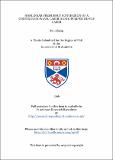Files in this item
Nonlinear frequency conversion of a continuous-wave, laser diode-pumped Nd:YLF laser
Item metadata
| dc.contributor.advisor | Dunn, Malcolm H. | |
| dc.contributor.author | Zhang, Jun | |
| dc.coverage.spatial | 187 p. | en_US |
| dc.date.accessioned | 2018-06-05T10:13:58Z | |
| dc.date.available | 2018-06-05T10:13:58Z | |
| dc.date.issued | 1996-07 | |
| dc.identifier.uri | https://hdl.handle.net/10023/13718 | |
| dc.description.abstract | A continuous-wave, frequency-doubled, diode-pumped Nd:YLF laser, capable of generating 1-W of single-frequency radiation at 523.5 nm, with a linewidth of 10 kHz and frequency tunability of 9 GHz has been developed. By using the tunable green laser as pump source, 4.5 GHz continuous smooth tuning in the range of 10<super>20</super> - 10<super>70</super> nm has been demonstrated in a low threshold doubly-resonant optical parametric oscillator. The investigation of thermal effect in the end-pump Nd:YLF laser crystal and the consideration of diode array end-pump geometry have led to an optimum folded-cavity design. Such an optical resonator can eliminate the astigmatism in the laser output, which is induced by the cavity folding on a curved mirror and the anisotropic thermal effect in Nd:YLF, resulting in a circular fundamental laser mode. In addition, a tightly focused beam waist is produced inside the cavity so that efficient intracavity SHG can be achieved. Over 30% optical conversion efficiency from diode to TEM00 10<super>47</super> nm laser output and 10% conversion efficiency from diode to single-frequency SHG green radiation has been demonstrated. A novel intracavity birefringent filter frequency selection technique has been applied in the standing-wave laser resonator to achieve the single-frequency operation. The performances of the laser in the fundamental wave and in second harmonic generation are investigated in detail in this thesis. The tuning behaviour and stability requirements of type-I and type-II CW doubly-resonant OPO have been compared by using the above green laser as the pump source and LBO, KTP as nonlinear crystals. Through utilisation of a simple cavity length servo, type-II phase matching allows single signal-idler mode-pair operation. By means of pump frequency tuning, and cavity length servo control, the output of signal and idler frequency can be tuned continuously over the KTP crystal phase-matching range. Theoretical analyses on diode-end-pumped Nd:YLF lasers, intracavity frequency doubling, the novel intracavity birefringent filter, and the timing behaviour and stability requirements of single cavity DRO are also presented in this work. | en_US |
| dc.language.iso | en | en_US |
| dc.publisher | University of St Andrews | |
| dc.subject.lcc | TK7871.3D5Z2 | |
| dc.subject.lcsh | Lasers | |
| dc.title | Nonlinear frequency conversion of a continuous-wave, laser diode-pumped Nd:YLF laser | en_US |
| dc.type | Thesis | en_US |
| dc.contributor.sponsor | University of St Andrews. Postgraduate Studentship | en_US |
| dc.contributor.sponsor | Oversea Research Student Award | en_US |
| dc.type.qualificationlevel | Doctoral | en_US |
| dc.type.qualificationname | PhD Doctor of Philosophy | en_US |
| dc.publisher.institution | The University of St Andrews | en_US |
This item appears in the following Collection(s)
Items in the St Andrews Research Repository are protected by copyright, with all rights reserved, unless otherwise indicated.

